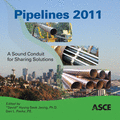Thrust Restraint Concepts and Beam Loads for Segmented Pipelines at Bends
Publication: Pipelines 2011: A Sound Conduit for Sharing Solutions
Abstract
Thrust restraint design of buried pipelines is dependent on the driving force distribution as well as pipe-soil interaction at the pipe-soil interface, which can be quite complex. The characteristics of the pipe-soil interaction are dependent on the piping configuration, pipe and soil mass properties, and internal and external loading, among other factors. It is generally recognized that a buried pipe has to move against the soil in order to develop maximum aggregate friction, adhesion, and lateral (passive) resistance forces, which in combination resist the unbalanced thrust forces. However, the design equations that are currently in use in the water/wastewater industry have been based on simplified assumptions that do not fully address the interfacial behavior, notwithstanding the recent AWWA M9 update. Pipe deformations or movements, in particular, can also cause additional pipe stresses (axial, bending and shear) on the pipe and/or deflection in the joints at or near the unbalanced forces. These additional effects are typically not considered in the designs of water/wastewater pipelines using most of the current AWWA pipe design manuals. In addition, with numerous joint configurations having varying capabilities of axial and rotational movement (flexibility) along with the complex behavior of the pipe-soil interaction, the amount of movement the pipe bends can safely be subjected to without causing excessive stresses on the pipe or joint itself is generally unknown. In 2010, the ASCE task committee on thrust restraint design of buried pipelines presented a draft White Paper that presented historical work, current practice and a preliminary framework for the design of thrust blocks and thrust restraint systems to improve current practice. Recognizing the widely different joint types used in practice, the white paper suggested this framework might eventually consist of two distinct design solutions: continuous (welded, fused or flanged) pipelines; and segmented (discrete) pipelines. This paper presents some further work of the task committee towards improving understanding concerning the behavior and design of thrust restraint systems employing restrained joints for segmented pipelines. While this paper offers some more basic information and issues, it does not presume to dictate a common restrained length calculation method, nor does it dictate a specific new strength analysis for all the various varieties of segmented piping materials and joint restraints, including those used with concrete, ductile iron, fiberglass, polyvinyl chloride (PVC), and steel pipelines. Also, while it only focuses on horizontal bend situations, and with a case study of ductile iron piping (DIP) with only some quite adverse differential loading and support conditions, it does however present some principles that might eventually be extended to more detailed examinations of more well-supported bends and other thrust situations.
Get full access to this article
View all available purchase options and get full access to this chapter.
Information & Authors
Information
Published In
Copyright
© 2011 American Society of Civil Engineers.
History
Published online: May 7, 2012
ASCE Technical Topics:
- Beams
- Bending (structural)
- Buried pipes
- Continuum mechanics
- Design (by type)
- Dynamics (solid mechanics)
- Engineering fundamentals
- Engineering mechanics
- Forces (type)
- Geomechanics
- Geotechnical engineering
- Infrastructure
- Joints
- Load factors
- Pipe joints
- Pipeline design
- Pipeline systems
- Pipes
- Soil dynamics
- Soil mechanics
- Soil-pipe interaction
- Solid mechanics
- Structural design
- Structural dynamics
- Structural engineering
- Structural members
- Structural systems
- Thrust
Authors
Metrics & Citations
Metrics
Citations
Download citation
If you have the appropriate software installed, you can download article citation data to the citation manager of your choice. Simply select your manager software from the list below and click Download.
